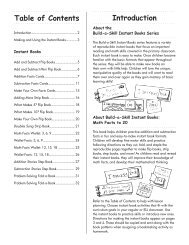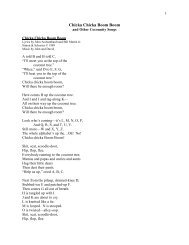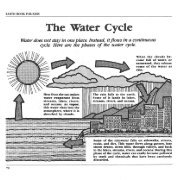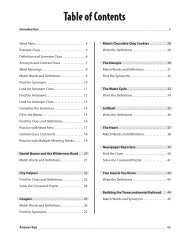Three Branches of Government Insert - Creative Teaching Press
Three Branches of Government Insert - Creative Teaching Press
Three Branches of Government Insert - Creative Teaching Press
You also want an ePaper? Increase the reach of your titles
YUMPU automatically turns print PDFs into web optimized ePapers that Google loves.
Social Studies Mini Bulletin Board Set<br />
<strong>Three</strong> <strong>Branches</strong><br />
<strong>of</strong> <strong>Government</strong><br />
<strong>Three</strong> <strong>Branches</strong> <strong>of</strong> <strong>Government</strong> is an interactive bulletin board set<br />
designed to help teach grades 3–5 how the Federal government <strong>of</strong> the<br />
United States is structured and the responsibilities <strong>of</strong> each branch. Use<br />
the content-rich panels to reinforce standards set forth by the National<br />
Council for the Social Studies listed on the following page.
National Social Studies Standards<br />
Understand the ways human beings view themselves in and over<br />
time.<br />
Understand the interactions among people, places, and<br />
environments.<br />
Understand interactions among individuals, groups, and<br />
institutions.<br />
Understand how people create and change structures <strong>of</strong> power,<br />
authority, and governance.<br />
Understand global connections and interdependence.<br />
Understand the ideals, principles, and practices <strong>of</strong> citizenship in<br />
a democratic republic.<br />
Display<br />
Separate the pieces, and laminate them for durability. Display the pieces <strong>of</strong><br />
the set on a bulletin board, magnetic whiteboard (magnets required), or in<br />
a pocket chart.<br />
Instruction<br />
Use the pieces for small-group work, class instruction, or at a learning<br />
center to preview the duties <strong>of</strong> each branch <strong>of</strong> government or those<br />
individuals who hold public <strong>of</strong>fice.<br />
Have students describe why there are three branches <strong>of</strong> the U.S.<br />
government.<br />
Have students explain the role <strong>of</strong> each branch <strong>of</strong> government.<br />
Have students summarize requirements for individuals who hold the<br />
different government <strong>of</strong>fices.<br />
English Language Development<br />
Use the pieces to introduce grade-level social studies content and academic<br />
language with pictorial input.<br />
Encourage groups <strong>of</strong> students to create a short skit that portrays a bill<br />
becoming a law. Encourage different groups to come up with different<br />
scenarios (e.g., one bill subject to a presidential veto, one bill signed into<br />
law by the president).
Make a list <strong>of</strong> questions about government in the style <strong>of</strong> a Jeopardy<br />
game. Students must answer in the form <strong>of</strong> a question. For example, you<br />
might say This person must be at least 30 years old, must be a U.S. citizen,<br />
and must live in the state he or she represents. The student will reply Who<br />
is a Senator?<br />
Integrating the Curriculum<br />
Language Arts: Have students research who their representatives are<br />
at the state and local levels. Ask each student to choose one <strong>of</strong> those<br />
leaders and write a summary <strong>of</strong> that person’s role in the government. Or<br />
as a class, brainstorm a list <strong>of</strong> questions students have and write a group<br />
letter to that leader.<br />
The names<br />
<strong>of</strong> our state<br />
senators are ...<br />
The state<br />
representatives<br />
for our<br />
district are ...<br />
Math: If the president vetoes a bill, it can still become a law if twothirds<br />
<strong>of</strong> the Senate and two-thirds <strong>of</strong> the House <strong>of</strong> Representatives<br />
vote to override the veto. Have students calculate the answer to the<br />
following questions: What is two-thirds <strong>of</strong> the House <strong>of</strong> Representatives?<br />
What is two-thirds <strong>of</strong> the Senate? How many votes does it take to make a<br />
majority in the House <strong>of</strong> Representatives? The Senate?
Teacher Background<br />
In 1787, leaders <strong>of</strong> the United States government gathered at<br />
Independence Hall to write the Constitution that has governed our nation<br />
for over 200 years. It took four months for Alexander Hamilton, James<br />
Madison, George Washington, and other important men to write the<br />
document. After many disagreements and compromises, they founded a<br />
government based on a system <strong>of</strong> checks and balances. They wanted to be<br />
certain that no one person or branch <strong>of</strong> government had too much power.<br />
For this reason, they divided the government into three parts: the<br />
legislative, the executive, and the judicial branches. The legislative branch<br />
is the congress. It legislates or makes the laws. The executive branch is the<br />
president and his advisors. The judicial branch is the Supreme Court and<br />
the lower courts. This branch judges or interprets the laws.<br />
Each branch <strong>of</strong> our democratic government checks and balances the power<br />
<strong>of</strong> another branch. The president can veto or reject any law proposed by<br />
Congress. Congress can override or pass a president’s veto. The Supreme<br />
Court can decide a bill is unconstitutional. Each branch must approve the<br />
actions <strong>of</strong> another branch. This system keeps each part <strong>of</strong> government<br />
from becoming too strong. By balancing the power <strong>of</strong> any part <strong>of</strong> our<br />
government, the power remains in the hands <strong>of</strong> the people, and our<br />
government remains a democracy.<br />
Vocabulary<br />
appoint—to choose for a job or <strong>of</strong>fice<br />
citizen—the resident <strong>of</strong> a city, town, or country who is entitled to the<br />
rights and privileges there (e.g., voting)<br />
executive—having administrative or managerial duties<br />
impeach—to charge a public <strong>of</strong>ficial with wrongdoing in <strong>of</strong>fice<br />
judicial—<strong>of</strong> or relating to judgment or judging<br />
legislate—to make or enact laws<br />
tyranny—government in which one ruler has absolute power<br />
veto—a power <strong>of</strong> the president to forbid the carrying out <strong>of</strong> legislation<br />
attempted by Congress<br />
937921-9 © 2007 <strong>Creative</strong> <strong>Teaching</strong> <strong>Press</strong> Inc.







